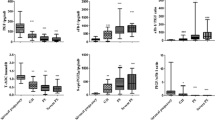Abstract
The present study was carried out to assess the biochemical profile and outcome of pregnancy and study the adverse consequences if any, among normal and high risk pregnant women. The study group included 182 normal and 168 high risk cases attending to private and Government Hospitals in Bangalore. The high risk groups were: Pregnancy induced hypertension (PIH), gestational diabetes mellitus (GDM), Adolescents and anemic cases. Lipid peroxidation was enhanced in PIH and GDM groups (5.56 nmol/ml and 3.98 nmol/ml) MDA values as compared to other groups. Vitamin E levels were significantly (p< 0.05) lower in PIH group (0.38 mg/dl) as compared to other groups. Caesarean as a mode of delivery indicating more number of complications were higher among GDM (61.9%) followed by PIH group. Incidences of low birth weight were observed more in PIH group. The study revealed occurrence of oxidative stress and adverse outcome among high risk pregnancy groups.
Similar content being viewed by others
References
Rana A. Oxidative stress in pregnancy-Role of antioxidants. Obstet Gynaecol Today 2004; 9(12): 810–813.
Schiff E, Friedman SA, Stampfer M, Kao L, Pamela RN, Barrett H, et al. Dietary consumption and plasma concentrations of Vitamin E in pregnancies complicated by preeclampsia. Am J Obstet Gynaecol 1996; 175:1024–1028.
Chaudhari L, Tandon OP, Vaney N, Agarwal N. Lipid peroxidation and antioxidant enzymes in gestational diabetes. Ind J Physiol Pharmacol 2003; 47(4): 441–446.
Kar J, Jina R, Srivastava K, Srivastava R, Mishra RK, Singh VB, et al. Serum magnesium level in normal and abnormal pregnancy. J Obstet Gynecol Ind 2001; 51(4): 38–40.
Satoh K. Serum lipid peroxide in cerebrovascular disorders determined by a new colorimetric method, Clin Chim Acta 1978; 90: 37–43.
Edinburg JR, Gillow J, Taylor RJ. The determination of total tocopherols. Analyst 1954; 79: 617–623.
Jellieffe DB. The assessment of the nutritional status of the community, 1966; WHO, Geneva.
Kharb S, Gulati N, Singh V, Singh GP. Evaluation of oxidative stress in preeclampsia. J Obstet Gynaecol Ind 2000; 50: 56–58.
Padalkar RK, Suryakar AN, Kulkarni KA, Rathi DB, Mane KK. Evaluation of lipid peroxides, glutathione peroxidase and vitamin E in pregnancy. Obstet Gynaecol Today 2001; 6(4): 211–212.
Mohanty S, Sahu PK, Mandal MK, Mohapatra PC, Panda A. Evaluation of oxidative stress in pregnancy induced hypertension. Ind J Clin Biochem 2006; 21(1):101–105.
Jayanth De, Mukhopadhyay AK, Saha PK. Study of serum lipid profile in pregnancy induced hypertension. Ind J Clin Biochem 2006; 21(2):165–168.
Seydoux J, Girardin E, Paunier L, Beguin F. Serum and intracellular magnesium during normal pregnancy and in patients with pre-eclampsia. Br J Obstet Gynaecol 1992; 99: 207–211.
NCEP. National Cholesterol Education Programme. Current Medical Scene-A Cipla update on therapeutics. 2001; 16(3):1.
Creasy F, Deswik J. Maternal fetal medicine-principles and practices. Mosby publication Toronto 1998.
Jayasree S, Kavitha T. Pregnancy induced hypertension and its effect on the fetus. Ind J Nutr Dietetics 2004; 41: 256–264.
Jadeja HB, Desai P, Hazra M. Perinatal outcomes in babies born to mothers with abnormally high maternal glucose levels a case controlled prospective study. J Obstet Gynaecol Ind 1993; 43: 20–23.
Jindal A, Ahmed F, Bhardwaj B, Chaturvedi B. Prevalence, clinical profile and outcome of Gestational diabetes mellitus. J Obstet Gynaecol Ind 2001; 51(4): 46–49.
Steven GG, Cornelia RG. Management of Diabetes Mellitus complicating pregnancy. Obstet Gynecol 2003; 102: 857–868.
Goel N, Sonal B. Diabetes in Pregnancy. Obstet Gynaecol Today 1999; 4(3):135–146.
Rey E, Attie C, Bonin A. The effects of first trimester diabetes control on the incidence of macrosomia Am J Obstet Gynaecol 1999; 181:202–206.
Bartha JL, Pillar MD, Fresno, Delgado RC. Gestational diabetes mellitus diagnosed during early pregnancy. Am J Obstet Gynaecol 2000; 182: 346–350.
Sharma JB. Iron deficiency anemia in pregnancy-still a major cause of maternal mortality and morbidity in India. Obstet Gynaecol Today 1999; 4(12): 693–701.
Author information
Authors and Affiliations
Corresponding author
Rights and permissions
About this article
Cite this article
Vijayalaxmi, K.G., Urooj, A. Biochemical profile and outcome in normal and high risk subjects. Indian J Clin Biochem 24, 269–274 (2009). https://doi.org/10.1007/s12291-009-0051-9
Published:
Issue Date:
DOI: https://doi.org/10.1007/s12291-009-0051-9




